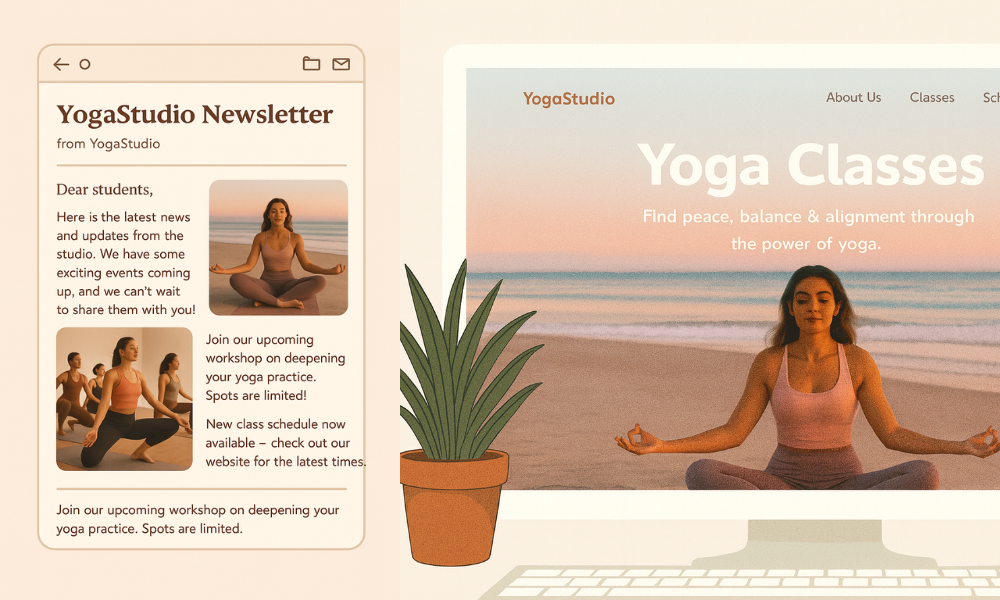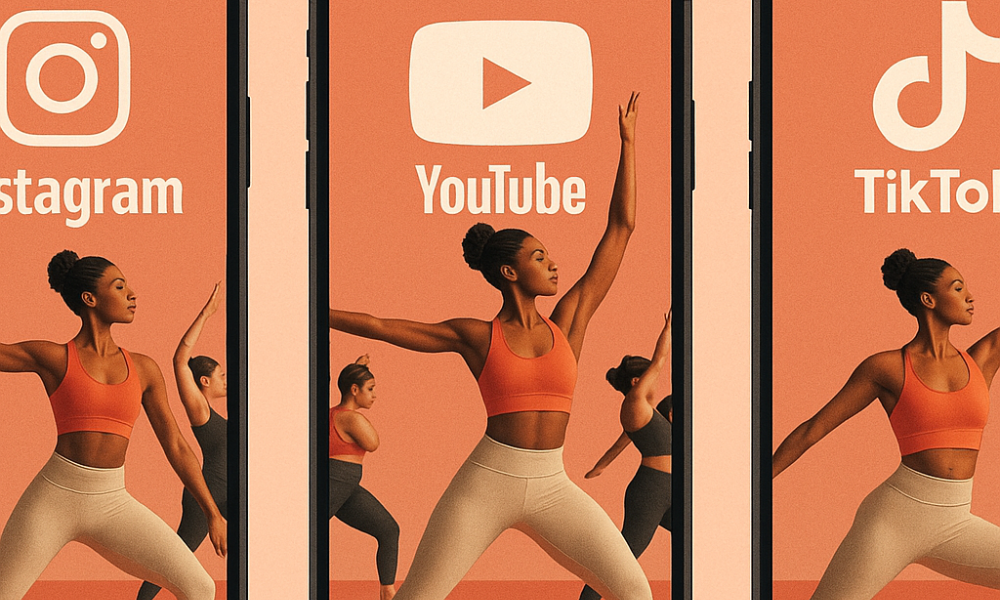Yoga marketing strategies and tips for yoga studio owners, and teachers alike.

Let’s be real for a second, being a yoga teacher today isn’t just about guiding people into downward dog.
You’re also an entrepreneur. And if that idea makes you a little uncomfortable… you’re not alone.
I didn’t become a yoga teacher because I loved marketing.
But here’s the thing: if you want your studio (or solo biz) to survive, let alone thrive, you have to fall in love with learning how to reach people.
That means email marketing, showing up on camera, writing newsletters (even when Mercury is in retrograde), testing Facebook ads, posting on social media, diving into SEO (so people can actually find your offerings), and exploring affiliate marketing if you want to build passive income streams that support your mission.
Yes, you might have to get uncomfortable, you might need to pivot fast, take a bank loan, or spend 3–6 months learning something totally new.
If you’re not curious and willing to evolve, it will be challenging. (I´m French, so maybe that is sounding a bit dramatic… but don´t you feel it sometimes that it is a bit much to handle it all?)
Being a yoga teacher in today’s world means becoming more than just a teacher. You need to embrace being a business owner, a creator, a communicator, and sometimes, even a tech nerd. One yogini I admire who does this well is Kelly McHugh from Digital Yoga Academy. She shows what it looks like to blend authentic teaching with smart strategy.
So if you’re in this for the long haul, this article is for you with its grounded, practical, and heart-centred yoga marketing strategies that can help your business grow, without losing the soul of your practice.
Why smart marketing matters more than ever in the yoga industry

The global yoga industry has experienced explosive growth, expanding from approximately $83 million to a staggering $290 billion, with over 215 million practitioners projected worldwide. What was once a niche wellness activity has become a global movement. (reference –Yoga statistics 2025: trends, participation, and growth)
This growth has been driven by yoga’s accessibility, mental and physical benefits, and its appeal across ages and lifestyles. During the COVID-19 lockdowns, millions of people discovered yoga from their living rooms, a trend that not only boosted interest but also introduced an entirely new wave of students to the practice.
But with increased demand comes increased competition.
As a yoga teacher, studio owner, or wellness entrepreneur, you know that you are no longer just competing with the studio down the street; you’re also up against YouTube instructors, fitness apps, and digital yoga platforms offering classes 24/7. The space is saturated, but there’s still room to stand out if you market with clarity, authenticity, and intention.
That’s where this guide comes in. I wanted to gather some top yoga studio marketing strategies to help your business grow, attract loyal students, and build a strong community, online and off. These tips are not exhaustive of course, and we would love ot hear from you on what else could be added to this article (editors@yogitimes.com)
Namaste, and let’s begin.

Key
Takeaways
- A strong brand is the foundation of your studio’s success, allowing you to connect with your target audience.
- A professional website and active social media profiles are key to visibility and engagement.
- Free community classes, price packages, and loyalty programs will bring in new students and retain existing ones.
- Email marketing is a low-cost way to stay connected with clients and promote special offers.
- Collaborations with influencers, local businesses, and the local community can get you more visibility.
- SEO, Google Business listings, and mobile-friendly designs help you be discovered by potential students and collaborators.
Create a unique brand

Build a Strong and Unique Yoga Brand
One of the most important yoga marketing moves you can make is building a strong, unique brand. I like to think of it the same way I think about designing a yoga flow: it has to be balanced, intentional, and truly reflective of who you are and what your studio stands for.
Your brand is not just a logo or a color palette. It’s the lifeblood of your yoga business, it flows through every class, every email, every Instagram post, and every interaction you have with your students.
One mistake I made early on as a yoga teacher was trying to do everything myself, including my branding. I spent hours (way too many) trying to figure out what looked good, what felt consistent, and what made sense… and I was exhausted. We all have our strengths, and doing the design myself was clearly not mine. I have a good sense of beauty and style, but the technicality of it kept making it a challenge for me.
That experience taught me something important: as a yoga entrepreneur, you need to get really good at outsourcing the things that drain your energy and take you forever to figure out. Your time and focus are limited, don’t waste them on tasks that pull you away from teaching, connecting, and growing.
The good news? Today, there are incredibly talented creatives who can turn around a brand identity that fits your vision perfectly, sometimes better than you could have imagined yourself. When your branding is aligned, clear, and professional, everything else in your marketing becomes easier.
Define your mission, it’s the heartbeat of your studio
Your mission is more than just words on your website, it’s the heartbeat of your studio, right? It’s what keeps everything aligned, from the way you greet new students to how you show up online. So really take a moment and ask yourself:
- What do I really want my yoga studio to be?
- Is it a safe space for total beginners who feel intimidated by yoga?
- A sanctuary for mindfulness and deep connection?
- A vibrant, inclusive community that empowers people beyond the mat?
Whatever it is, say it clearly, not just for your audience, but for yourself. Having a strong, heartfelt mission will guide your marketing, your teaching, and every decision you make.
When I finally sat down and wrote mine, it surprised me how grounding it felt. It wasn’t just a tagline, it reminded me why I started this in the first place.
Your mission doesn’t have to be fancy. Something like:
“Empowering individuals to find balance through yoga, community, and mindfulness practices.”
…can say everything someone needs to know. It’s not about sounding perfect, it’s about being real, and rooted.
Tone and visual identity

We all know that consistency really matters, but not in a rigid, corporate way. It’s more about people being able to recognize you wherever they meet your studio. Whether someone lands on your website, scrolls past your Instagram, or picks up a printed flyer, it should feel like the same place, the same energy.
Think about how you want people to feel when they interact with your brand. Calm? Supported? Uplifted? That feeling should show up in your colors, your photos, and even the way you write captions or emails. Soft, grounding tones. Friendly, human language. Maybe a little quirkiness, too, like featuring your studio dog, your plants, or those small details your students already love about being there.
When your visuals and tone reflect your personality, people sense it immediately. It builds trust without you having to “sell” anything. The right students — the ones who truly resonate with your space — will feel it and naturally want to be part of your community.
Find and Own Your Unique Edge

One of the most powerful things you can do for your yoga business is to figure out what truly makes you different. That’s your Unique Selling Proposition, also called a USP. It’s the thing that makes someone say, “Yes, I want this studio,” instead of the one down the street or the app on their phone.
Your USP is not just about being better, it’s about being you. More specific. More real.
When I created my UPS at the time as a yoga teacher I asked myself these questions:
- What is it that students remember or talk about after my class?
- What kind of energy or experience do I offered that others didn´t?
- What was I naturally great at that others overlook?
For example, maybe you offer:
- Yoga classes with live music, creating a full sensory experience that students can’t get anywhere else.
- Tiny class sizes with candlelight and tea after, so people feel seen, not just part of a crowd.
- A hybrid model, where students can tune in online when life gets hectic, but still feel part of your in-person community.
For me personally, it took some trial and error. I was teaching everything to everyone until I realized my strength was creating space for people who felt awkward or intimidated by yoga. One of my target students became men who workedout a lot in other sports, but would never enter a yoga class. Once I leaned into that, my classes filled up with exactly the people I wanted to serve.
Whatever your unique offering is, make it the heart of your next yoga marketing plan. Let it guide your messaging, your visuals, even your class titles. The more clearly you can communicate your difference, the easier it becomes for the right students to find you.
Show off your yoga business
Your brand needs to be visible across all platforms. That includes your website, emails, social media, and even signage. This way, your studio has a clear presence and can be easily recognized by your current and future clients.
Who’s your target audience

Defining your target market and the yoga marketing strategy is like finding your center in a tricky pose: it requires focus and awareness.
When you know who you’re talking to, you can create a yoga marketing plan that speaks directly to your target audience.
Understand your local demographic so that you can address their needs and present your classes as the answer to the issues your community may be facing.
This way, your yoga marketing ideas will connect with your target market.
Research and create buyer personas
To help you refine who might want to attend your classes, create detailed profiles for your ideal clients. For example:
- Emma: 28, loves hot yoga and posts her workouts on Instagram.
- Dan: 50, wants to improve flexibility without feeling like a beginner.
- Carol: 39, uses yoga as her dedicated me-time.
What yoga services can you offer to these people? How many people practice yoga? How can you attract more clients of the same type?
Professional website for your studio

Your website is the equivalent of a business card and a restaurant menu. It needs to be attractive and functional to make a good first impression on potential students, yoga teachers, and collaborators.
A poorly made website can turn people away in favour of someone else’s studio. It’s worth investing in professional website development and design to avoid this.
Since smartphones and tablets are so commonplace, you also need to ensure that your yoga website and booking system have a mobile-friendly option. Here is a sample of a fast-loading and visually appealing website called Swasti Eco Cottage.
What to include on your website
- Home Page: User-friendly and attractive.
- About: Tell your story, introduce your teachers and define your studio values.
- Class schedule: Make it easy to navigate and always up to date.
- Pricing: Break down the yoga services you offer.
- Reviews and testimonials: Elevate your students’ voices and promote your classes at the same time.
- Contact: Have a direct line of communication and link your website to your socials.
Images and videos

Make sure to include high-quality photos and videos of your studio, happy students, and teachers.
Use authentic images of real people; avoid stock photographs. Follow Gael and Authority Hackers on YouTube to get free video marketing tips.
Add CTAs
CTA, or “call to action”, is a common marketing technique that reminds your clientele to engage with your products and services.
Whether you encourage visitors to book classes, join your newsletter, or contact you – it’s a simple and direct approach within a yoga marketing plan. Example: Launch your online Yoga Business
Start collecting testimonials early on

For years, I completely overlooked the power of testimonials. I was so focused on teaching, improving my sequences, and growing my classes that I just… never asked. I assumed people would leave reviews if they wanted to. They didn’t. Not because they didn’t love the class but because I never invited them to share.
It wasn’t until much later, when I started working on my website and realized I had nothing to show for all the work I’d done, that it hit me. I’d missed so many opportunities to collect kind words, social proof, and real reflections that could have helped my future students feel safe and excited to join.
Now I always say: ask for a testimonial from your very first class. You’ll be surprised how generous people are. Students love to share their experience, especially when the class moved them, calmed them, or simply made their day better.
Here’s how to make the most of them:
- Ask directly and warmly. After class, or in a follow-up email, say something like: “If you enjoyed the class, would you mind sharing a quick review on Google? It really helps others find the studio.”
- Make it easy. Include the link. Keep the ask short. Let them know it doesn’t have to be long or perfect just authentic.
- Use the feedback. Post glowing reviews on your website, in your newsletters, and on social media (with permission or initials if needed). That real, human connection builds trust faster than any ad ever could.
- Respond to everything. Thank people for the kind words, and respond to criticism with openness and professionalism. It shows you care and that you’re always learning.
Don’t wait like I did. Start collecting those beautiful words now, they’ll be one of the most valuable tools in your yoga business toolkit.
Search Engine Optimization (SEO) – the ongoing love/hate story with Google
SEO used to be our golden ticket at YOGI TIMES. For years, we ranked organically for high-intent keywords like “yoga teacher training Costa Rica” and “retreats in Bali.” We didn’t rely on ads.
Our authority and consistent content brought in a wave of organic traffic that helped us sell courses, fill retreats, and grow without shouting. It worked beautifully… until it didn’t.
Now, the algorithm has shifted. Google’s gotten fussier. Competition is fiercer. AI is cluttering up the SERPs. So we’ve had to pivot, not abandon SEO, but adapt. We’re moving into e-commerce, expanding YTT listings, and launching into markets like Mexico and Dubai. SEO is still part of our core strategy, but it’s a long game, not a lucky break.
So if you’re a yoga teacher trying to grow your brand, here’s what I wish someone had told me sooner:
Start with keyword research, not just any keywords, but the ones with transactional intent. These are words people type when they’re ready to buy or book, like “online 200hr yoga training” or “private yoga classes in LA.” Build your site’s money pages around those.
Then comes structure: think content clusters. One main service page (like your YTT offering), supported by multiple blog posts or guides that link back to it. That’s how Google sees your content as authoritative.
And within those pages, vary your anchor text, the clickable words in links. Use phrases like “200hr YTT New Mexico” or “beginner-friendly yoga immersion,” not just “click here.”
Internal links help. But backlinks? They still reign supreme.
We’ve spent months reaching out to blogs for free backlinks. It’s exhausting. (unless you automatize the outreach or hire a team). So yes, I recommend paying for quality links from real wellness sites.
Backlinks are trust signals. Google still listens. Just don’t buy them from shady sources. We use platforms like Make.com to automate outreach now, but even then, you’ll need to invest time, energy… or money.
Better yet, get your brand mentioned on other sites. Even if there’s no link, Google picks up those signals too.
We’ve seen it firsthand at YOGI TIMES. A single mention on a niche blog with real traffic gave one of our retreat pages a serious ranking bump.
That’s when I stopped seeing backlinks as “extra”, and started treating them like digital assets.
Also, and this is key, if SEO feels overwhelming, don’t do it all yourself. Teach yoga.
Show up in your truth. But if you’re serious about growth, hire help as soon as you can afford it. Take a small business loan if you need to. Just be intentional with how you spend it. SEO is a long-term investment, not a quick fix.
Also, it is important to learn the difference between white hat SEO (ethical and sustainable) and black hat SEO (manipulative and risky). Stick with the white. Educate yourself through trusted voices. I personally follow Matt Diggity and Niche Pursuits. They keep it real.
And never forget: SEO isn’t just about pleasing Google, it’s about trusting your own voice. Google rewards content with realness.
Use your face. Share your story. Let your words feel a little imperfect. (We do this on purpose; even a tiny syntax error can make your content feel more human.)
Some people will love your vibe. Others won’t. That’s okay.
The ones who resonate with you will follow you across continents, to your retreats, trainings, product launches, whatever you’re building. I’ve seen it happen again and again.
Your 2026 SEO Checklist (In order of what moves the needle)
- Backlinks & Brand Mentions: From real, relevant, high-traffic wellness or yoga sites. Pay for them if needed. It’s worth it.
- Transactional Keywords, start with high-intent search terms that convert.
- Content Clusters/Silos, support your main service pages with blog content that links back.
- Anchor Text Variations, don’t just use one phrase; mix it up naturally.
- Internal Linking Strategy, helps bots crawl your site and improves indexation.
- On-Page Optimization, think meta titles, headers, and images with alt text.
- Avoid Keyword Stuffing, google’s smarter. Use variations and speak human.
- EEAT Signals – show experience, use your name, face, and real-life stories.
- AI Content? Re-Optimize, use tools like SurferSEO to stay competitive, but don’t sound robotic.
- Play the Long Game, SEO takes time. But when it works, it really works.
Want to skip SEO entirely?
Then go hard on email marketing or paid ads. But if you’re dreaming of long-term visibility, a steady stream of warm leads, and authority that compounds over time, SEO is still your best friend. Just… treat it like you treat yoga: with patience, persistence, and a willingness to evolve.
Get found with google business & maps
Optimizing your Google Business profile might not feel like the most exciting part of your yoga marketing plan but it’s one of the most important. When someone searches for “yoga near me,” you want your studio to show up, with accurate info, inviting photos, and glowing reviews.
Making sure your profile is fully set up and regularly updated means new and returning clients can find you easily, whether they’re searching on Google Maps, desktop, or their phone while walking down the street.
Here’s how to make the most of it:
- Verify your Google Business listing and double-check that your contact info, hours, class descriptions, and location are correct. Even small errors can lose you a client.
- Upload high-quality photos of your space, classes, and community, not just logos or stock images. People want to feel what it’s like before they visit.
- Encourage reviews and respond to them, Google favors businesses that engage. Reply to kind feedback with gratitude, and handle any issues professionally and calmly.
- Add a map to your website’s contact page so students can get directions easily (and it boosts your local SEO, too).
This step may seem small, but when it comes to local search visibility, it can make all the difference. A well-maintained Google listing gives people confidence that you’re legit, active, and ready to welcome them.

Reconnect with potential students using retargeting

Have you ever noticed that after visiting a website, you start seeing ads for it everywhere? That’s not magic, it’s retargeting, and it’s one of the most effective marketing tools you can use to turn curious browsers into committed students.
Many people visit your yoga studio’s website or social media out of interest, but they don’t always take action right away. Maybe they were just browsing, comparing options, or got distracted. Retargeting allows you to gently stay on their radar and remind them why they were interested in the first place.
What is retargeting (in simple terms)?
Retargeting works by placing a small piece of code (called a cookie) on a visitor’s browser when they land on your site. That cookie lets you show ads specifically to those same people as they browse other websites or scroll through platforms like Instagram, Facebook, or YouTube.
It’s a way to say:
“Hey, remember us? Here’s that intro offer you were eyeing.”
How to use retargeting for your yoga studio
- Promote time-sensitive offers like discounted memberships, free class trials, or seasonal events.
- Remind drop-offs who visited your booking page but didn’t sign up.
- Highlight testimonials or success stories to build trust and encourage return visits.
Best platforms for retargeting
- Facebook & Instagram Ads – Great for visual, lifestyle-focused content.
- Google Display Network – Lets you show ads on websites your audience visits daily.
- YouTube Pre-Roll Ads – Perfect for video teasers or short intro-to-your-studio clips.
Bonus tip: Make sure your retargeting ads feel aligned with your studio’s energy, warm, welcoming, and helpful. Keep your visuals, tone, and offers consistent with the rest of your brand so your ads feel familiar, not pushy.
Use email marketing to stay connected and grow

Email marketing is one of the most effective (and affordable) tools you can use to promote your yoga studio and stay top-of-mind with your community. Unlike social media, which can be unpredictable and algorithm-driven, your email list is something you own, and that’s powerful.
With just one email, you can reach a wide audience that includes:
- Existing students
- Curious first-timers
- Retreat participants
- Fellow yoga instructors
- Wellness professionals and collaborators
Whether you’re announcing a new workshop, offering a special deal, or sharing tips and inspiration, email keeps the relationship going outside of the studio.
Build and nurture a valuable email List
A strong mailing list is one of your most valuable business assets. To grow it, offer an incentive, like a free digital class, PDF guide, or exclusive discount, in exchange for an email signup.
Example: At YOGI TIMES, we offer a pop-up that appears 45 seconds after someone lands on our site, inviting them to join the community in exchange for a helpful resource.
Make sure to promote your email signup across your:
- Website
- Instagram bio
- Class registration forms
- In-studio signage
Once they’re on your list, it’s all about nurturing that relationship with helpful, relevant content, not just sales.
Automate and personalize your messaging

You don’t need to manually send every email. With today’s tools, you can set up automated workflows that feel personal, save time, and improve student retention.
Here are some great ideas for automation:
- Class reminders
- “We miss you” follow-ups
- Personalized birthday greetings
- Welcome sequences for new students
Popular yoga studio platforms like Momoyoga, WellnessLiving, and Mindbody offer built-in tools for email automation, making it easy to deliver a personal touch without extra admin work.
Tools we recommend (beyond the basics)
If you’re looking for email platforms that understand the yoga and wellness space, here are two worth checking out: NamasteLight, created by Chris and Rose, two amazing yogis based in Texas. NamasteLight is designed specifically for yoga and wellness businesses. It offers elegant templates, intuitive design, and a soulful approach to communication as well as a real hands-on personalised support. We have personally used Namaste for years, and it has been a flawless experience so far.
If you’re on a tight budget or want something all-in-one, Systeme.io is a fantastic solution. You can start for free (up to 2,000 emails) and scale up to unlimited emails for just $99/month. It includes landing pages, automations, and even course hosting.
Use AI to personalize & optimize your email content

Instead of staring at a blank screen, you can use AI to help draft, edit, or enhance your emails, especially welcome sequences, announcements, and newsletter content. AI tools can suggest better subject lines, fix tone and grammar, or even write entire emails based on prompts you give.
Recommended Tool: Check out the AI content tool from Matt Diggity (SEO expert) for improving your email and website copy. It’s designed to help make your messaging more friendly, engaging, and SEO-optimized. (Note: You may need a subscription to GPT-based services to use it fully.)
Use AI to Repurpose Long Videos into Short-Form Content
You don’t need a full-time editor to create social media content anymore. AI video tools can quickly turn your class recordings, interviews, or tutorials into bite-sized videos perfect for TikTok, Instagram Reels, or YouTube Shorts, which are currently huge for engagement.
Top Tools to Try:
- Opus Clip: Automatically finds highlight moments and adds captions.
- Video.ai : Great for turning full yoga sessions or livestreams into short, shareable clips.
These tools not only save you hours of editing but also help you stay active on social without constantly filming new content.
Keep It Real
AI is a tool, not a replacement for your voice, your teaching, or your presence. Use it to assist and streamline your workflow, but always bring your own tone, story, and authenticity into everything you publish. That’s what your audience will connect with most.
Social media content
Social media platforms like Instagram, TikTok, and YouTube are a must for yoga and yoga-only marketing strategies.

Share stories and behind-the-scenes moments
One of the most powerful ways to build connection and trust with your audience is to show the human side of your yoga business. People don’t just want to see polished poses or studio promotions; they want to see you, your team, your students, and the real energy behind your brand. Share student testimonials, before-and-after stories, and real client transformations (with permission, of course). These help others see what’s possible when they commit to their practice with you.
You can also pull back the curtain with behind-the-scenes content, think setting up the studio before class, team meetings, bloopers, or even the not-so-glamorous parts of running a wellness business. This kind of content makes your brand more relatable and shows that you’re not just selling classes, you’re building a community.
Bonus tip: Try using short-form video (like Instagram Reels or TikTok) to bring these stories to life. You don’t need to be perfect, just honest and present. People resonate with authenticity far more than perfection, and consistent and authentic posts will grow your audience and build trust.
Go live and collaborate with others in the wellness workspace
If you’re not already using live video as part of your yoga marketing strategy, you’re missing a big opportunity to connect with your audience in real time. Hosting live classes, mini workshops, or even quick pose breakdowns is one of the best ways to build trust, show your teaching style, and answer questions on the spot, no editing, no filters, just a real connection.
Live Q&A sessions can also be powerful for addressing common struggles your students face (like wrist pain in downward dog or how to stay consistent with home practice). These kinds of interactive moments position you as an expert and also make your audience feel seen and supported.
Don’t be afraid to team up, either. Collaborating with wellness influencers, fellow yoga teachers, fitness professionals, or even mental health practitioners can expand your reach and add value to your content. For example, you could host a joint Instagram Live with a nutritionist on the topic of “yoga and mindful eating” or invite a local PT to talk about injury prevention for yogis.
Cross-promotion helps everyone grow, and it shows your audience that you’re not just focused on your platform, you’re building a wider network.
Highlight your community with user-generated content (UGC) and develop an organic social media strategy
One of the most authentic forms of marketing is when your students become your storytellers. User-Generated Content (UGC) is not just a social media trend, it’s a trust builder. Encourage your students to share their yoga journey, tag your studio in their posts, or use a branded hashtag when they attend your classes, workshops, or events.
Reposting their photos, videos, or testimonials (with credit, of course) does two things: it validates their progress and experiences, and it shows potential students that real people, not models or influencers, are benefiting from your offerings. This is especially powerful for prospective students who are nervous about joining or unsure if yoga is “for them.”
You can even take it a step further by creating UGC campaigns. For example, run a monthly challenge like #MyMorningFlow or #YogaWith[YourStudioName] where participants post their daily practice or thoughts. What I have witnessed work really well is to offer small incentives like a free class, studio swag, or a feature in your newsletter.
Most importantly, respond and engage with every tag and share. When your students feel seen and celebrated, your community becomes your most powerful marketing team, no ad spend required.
Aim to build meaningful connections. This way, you can build your following organically by understanding what people respond to.
Allow your teachers to share their stories with others. Quick responses to messages and comments can also create a feeling of connection with other people.
Building local community

Partner with local businesses
Look beyond yoga and collaborate with health food cafes, juice bars, gyms, massage therapists, and wellness centers. Cross-promote services through referral cards, co-hosted events, or bundled wellness packages. It’s a win-win: their clients hear about you, and yours discover complementary wellness options. Bonus: it helps you tap into audiences who already care about health and mindfulness.
Host community classes outdoors
Bring your classes to local parks, rooftops, beaches, or community centers by offering free or donation-based yoga. These sessions are welcoming to beginners and create a vibe of inclusivity. Plus, they double as mini marketing campaigns when people share their experience online. Pack some business cards or set up a signup sheet to keep the connection going.
Sponsor or attend local events
Support community wellness fairs, charity events, or local races. You don’t need a huge budget; even showing up with a booth, offering mini chair massages, or handing out free class passes builds visibility. It also shows that your studio cares, not just about business, but about people.
Offer free trials and intro deals
Free trials, discounted first classes, or “bring a friend” days lower the barrier for new students and get your name into more conversations. Just make sure their first experience is welcoming, clear, and memorable — it’s not just a free class; it’s your first impression.
Bonus Tip: Create a community board in your studio (or digital version on your Instagram highlights) to feature local partners, community updates, or student shoutouts. It reinforces that your studio is part of the community, not just a business operating in it.
Partner with Local Businesses
To expand on a previous point, one of the best yoga advertising ideas is collaboration with local organizations.
Try to locate businesses that offer a wellness service or product to customers, but are not direct competitors in the yoga industry. You may work with a fitness apparel store or a SPA, for example.
Host workshops and retreats to deepen connection

Yoga events, whether it’s a one-day workshop or a full-blown retreat, are powerful tools for attracting new students and nurturing the ones you already have. These experiences go beyond the mat. They create space for growth, reflection, and real community — which is what keeps people coming back.
Workshops are a great way to dive deeper into specific topics your regular classes don’t always allow for: think “Inversions 101,” “Breathwork for Stress Relief,” or “Yoga for Lower Back Pain.” These focused events can draw in both your current students and new faces searching for help with a specific issue.
Retreats, on the other hand, offer an immersive experience that transforms casual students into lifelong supporters. Whether local or international, yoga retreats give people the chance to fully unplug, reconnect, and go deeper into their practice — often with lasting results for your business and your students’ well-being.
If you’re thinking of organizing your own retreat, be sure to read: How to Host a Yoga Retreat (Step-by-Step Guide)
This article breaks down everything from planning your itinerary to pricing and legal considerations.
And if you’re looking for inspiration or a real-world example of a successful retreat, check out this feature: Bali Yoga Retreat Experience
It beautifully captures how thoughtful design and intention can turn a retreat into a transformational journey.
Of course, promoting your events is key. Use a mix of email marketing, social media content, and personal outreach (DMs, chats after class) to spread the word. Share early-bird offers, testimonials from past attendees, and behind-the-scenes prep to create excitement and urgency and start promoting way in advance. We recommend at least 6 months before the yoga retreat.
Guide students with a yoga content marketing funnel
A well-structured content marketing funnel is one of the most effective ways to attract new students, build trust, and guide them toward becoming loyal, long-term members of your yoga community.
Rather than pushing one-size-fits-all content, a funnel helps you meet people exactly where they are in their journey, from first discovering yoga to finally booking a class or retreat. It ensures your marketing strategy is thoughtful, nurturing, and aligned with how real people make decisions.
Here’s a tip on how to structure your yoga content funnel:
Top of Funnel (awareness)
Goal: Reach a broad audience and build initial interest.
At this stage, people are just discovering yoga — or your studio. Your job is to educate, inspire, and position yourself as a trusted voice. Focus on creating engaging, shareable content that introduces yoga in an approachable way.
Example content:
- Blog post: “5 Beginner-Friendly Yoga Poses for Desk Workers”
- YouTube video: “What Is Vinyasa Yoga? A 5-Minute Intro”
- Instagram Reel: “3 Benefits of Practicing Yoga Daily”
This type of content helps you reach more people and builds top-of-mind awareness — even if they’re not ready to buy yet.
Middle of Funnel (consideration)
Goal: Build trust and offer value to people considering their options.
At this point, your audience already likes the idea of practicing yoga — they’re just not sure where or how to start. Your content should help them get to know you better and give them a reason to take the next step.
Example content:
- Free trial class or 7-day intro offer
- Lead magnet: “Downloadable Yoga for Stress Relief eBook”
- Email course: “Intro to Yoga in 5 Days”
- Social proof: student testimonials or behind-the-scenes videos
Make sure this content feels generous, low-risk, and builds a sense of community. You’re not selling yet — you’re supporting.
Bottom of Funnel (decision)
Goal: Convert interest into action.
This is where your warm audience is ready to commit — they just need a clear, compelling reason to do so. Make it incredibly easy for them to say “yes.”
Example content:
- Direct calls-to-action like “Book Your First Class Today”
- Limited-time promotions or early-bird retreat pricing
- Booking page links in all your emails and social posts
- Reminder emails for abandoned sign-ups
Your offers should be visible, irresistible, and seamlessly integrated across your website, emails, and social channels.
Bonus tip: Use automation to guide the journey
Use tools like Systeme.io, ActiveCampaign, or Momoyoga to automate your funnel. For example, someone who downloads your eBook (middle of funnel) can be automatically added to an email sequence that leads them to a special intro offer (bottom of funnel). This makes your marketing work for you while you focus on teaching and building community.
Also Read>>> How to make money as a Yoga teacher
Membership and loyalty programs

If you want to create more stability in your yoga business, both financially and in terms of student retention, membership models and loyalty programs are essential. These systems not only help you generate predictable monthly income, but they also give students a reason to keep coming back to you instead of hopping between studios or apps.
A solid membership model offers value and flexibility. Whether it’s unlimited in-person classes, on-demand video access, or hybrid options, your goal should be to make students feel like they’re getting more than just a class; they’re investing in a lifestyle.
On the retention side, loyalty programs help reward consistency and build deeper relationships. Think punch cards with a free class after 10 visits, referral perks, member-only events, or wellness bundles that include things like massage, coaching, or nutrition consults. These little touches help your students feel seen, appreciated, and motivated to stay engaged long-term.
Don’t forget the onboarding experience. New students often feel overwhelmed or unsure where to start, especially if they’re new to yoga. A simple, personalized welcome path can make a big difference. This could include a short email series with class recommendations, studio etiquette tips, or even a quick call or message from a team member to say hi and answer questions.
Bonus Tip: Use automation to nurture both new and long-time members. Create segmented email flows for:
- New signups (“Welcome to our yoga family!”)
- Milestone check-ins (“You’ve been with us for 3 months!”)
- Reactivations (“We miss you — here’s a free class to come back.”)
These small touches build community and brand trust, and trust leads to retention.
Also Read>>> YOGI TIMES Yoga Business Section
Networking

Expand your reach through strategic networking
While digital marketing is essential, real relationships still play a major role in growing a yoga business, especially if you want to stand out in a crowded space. Strategic networking helps you get in front of new audiences, build credibility, and unlock growth opportunities that go beyond the screen.
Connect with influencers (thoughtfully)
Instead of working with generic influencers, seek out local voices or micro-influencers whose followers align with your vibe, people who already care about wellness, community, and personal growth. Invite them to a free class, event, or retreat preview, and let them experience what makes your offering special.
Be active in wellness communities
Join (or start) groups that align with your values, whether it’s a local yoga teachers’ circle, wellness mastermind, or a private Facebook group where your ideal clients hang out. Show up consistently, contribute meaningfully, and you’ll naturally become a go-to expert in the space.
Partner with complementary professionals
Look for partnerships that add value to your students’ lives. Collaborate with massage therapists, holistic coaches, nutritionists, or acupuncturists to host events, share client referrals, or co-create content. It’s not just about exposure — it’s about becoming part of your clients’ full wellness journey.
FAQs
Yoga is marketed through digital and traditional methods. This includes social media marketing, paid ads for visual content, email marketing for scheduling and promotions, paid ads and SEO to get found online.
Offline methods like hosting community events, partnering with local businesses, and word-of-mouth yoga marketing out-of-mouth referrals work too.
Yes, the yoga market is growing. Increased interest in health and wellness has made yoga a multi-billion dollar industry globally. Trends like online classes and wellness retreats are expanding the market for yoga practitioners.
Yoga can be advertised through paid ads on your social media platforms, Google Ads, and local print media. Highlight your unique offerings like beginner classes, workshops, or discounts in your paid ads.
Visuals and clear CTAs are the keys to good, yoga marketing ideas and advertising and the yoga marketing plan ideas to grow them.
Yes, yoga can be a money-making local business if done well. Offering in-person and online classes, workshops, yoga retreats, and merchandise can create multiple income streams. Building a loyal community and a strong brand is key to long-term profitability.
You can get yoga students by offering free trials, engaging with potential students on social media, and leveraging referrals helpful tips from existing yoga instructors, former yoga instructors, lovers, and students.
Email yoga marketing campaigns and partnering with local yoga businesses can also bring in new clients to your own yoga class schedule or your yoga studio owners website.
Advertise on your social media channels, your studio’s website, local community boards, and wellness apps. Also, list on Google My Business and collaborate with local other yoga instructors and businesses to get visible.
Market yourself as a yoga teacher by creating a personal brand that reflects your values and teaching style.
Use social media to showcase your expertise, share testimonials, and connect with your target audience. Networking with other wellness professionals and attending local events can also get you more visibility.
Market a yoga workshop through email campaigns, social media posts, and partnerships with local yoga businesses. Create visual content and highlight the benefits of the workshop. Early bird discounts and limited-time offers can get people to sign up.
Yoga teachers make the most money in metropolitan areas where there is high demand for wellness services.
Offering private lessons, corporate yoga sessions, and specialty classes like prenatal or therapeutic yoga can also increase income.
Get more sales at a yoga studio by offering membership packages, loyalty programs, and special offers. Host workshops free classes, and community events and collaborate with influencers to attract new clients get more clients.
Good customer service and a warm environment is also key.
Yoga business means yoga programs for corporate clients. These sessions are designed to reduce stress, improve focus, and promote employee well-being in the workplace.
It’s an excellent way to introduce virtual yoga classes to new audiences while creating additional revenue streams.
A yoga studio website is special when you offer unique experiences like themed classes, small class sizes, hybrid online and in-person sessions and personalized instruction. Building a community, having a brand personality and providing great customer service also sets you apart.
Yoga teachers keep students by building personal connections, offering loyalty programs and communicating consistently through newsletters and social media. Updating classes regularly, addressing individual student goals and creating a warm environment also keeps them coming back.
Price should reflect the yoga marketing plan, your experience and what you offer. Consider tiered pricing like single class rates, class packs and monthly memberships. Discounts for new students or special packages for loyal students will attract and keep students.




